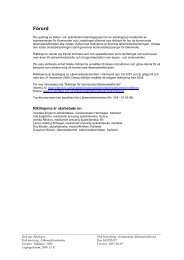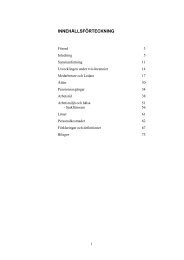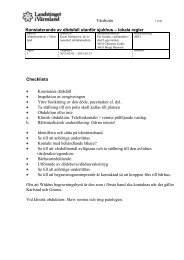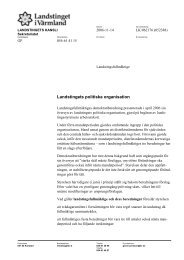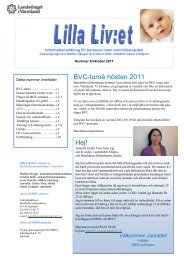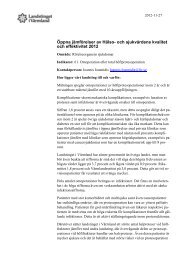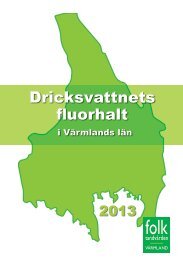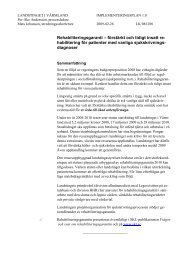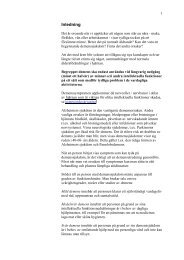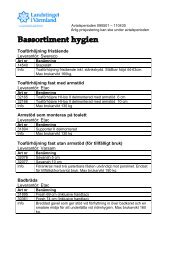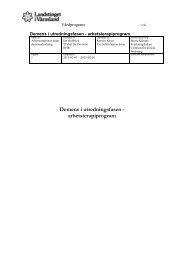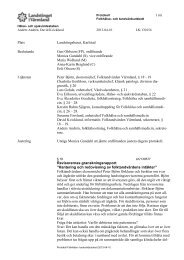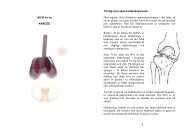Severs skada – paradigmskifte gällande diagnostik och behandling?
Severs skada – paradigmskifte gällande diagnostik och behandling?
Severs skada – paradigmskifte gällande diagnostik och behandling?
You also want an ePaper? Increase the reach of your titles
YUMPU automatically turns print PDFs into web optimized ePapers that Google loves.
Perhamre et al.<br />
following year were also asked about. Three boys did not<br />
answer, leaving n 5 41.<br />
Pain was assessed with Borg’s CR-10 scale (Neely et al.,<br />
1992). It is a VAS scale with anchors of verbal explanations<br />
added to the numbers in the pain scale, and was used for<br />
measuring pain associated with the two sports activities<br />
chosen by each boy. Zero was absence of pain and 10 was<br />
maximal pain. These self-assessed pain recordings were<br />
made in direct relation to training and sport events, and<br />
were answered with no influence from the investigators.<br />
Activity level was measured with Engstro¨ m’s activity index<br />
(Engstro¨ m, 2004), which includes five levels of physical<br />
activity, A<strong>–</strong>E and assessed at start, at phase shifts and at the<br />
end of week 26.<br />
When soccer was one of the chosen activities (n 5 33), it was<br />
always chosen as the first activity A, producing the highest<br />
levels of heel pain. Running was the dominating activity<br />
chosen as activity B (n 5 29). A majority of the boys (n 5 26)<br />
had soccer as activity A, and running as activity B.<br />
The study has been approved by the Regional Ethics Board<br />
of Uppsala, Sweden (dnr 2004 M-377).<br />
Neither the Public Sports Medicine Clinic nor the authors<br />
have any relation to, profit or other benefits from the<br />
companies that manufacture the products in this study.<br />
Table 1. Baseline characteristics for the primary heel wedge group and<br />
the primary heel cup group at study start<br />
Primary heel Primary heel<br />
wedge cohort cup cohort<br />
Patients, numbers 24 20<br />
Median age, years (range) 12 (10<strong>–</strong>14) 12 (9<strong>–</strong>14) P 5 0.844*<br />
Median pain level (IQR) 4 (2.75) 5 (3.75) P 5 0.149*<br />
Pain history, weeks (range) 8 (4<strong>–</strong>25) 12 (4<strong>–</strong>24) P 5 0.102*<br />
*P-values computed using the two-tailed asymptotic Mann<strong>–</strong>Whitney<br />
U-test.<br />
IQR, interquartile range.<br />
Table 2. The results of the first randomized 12 weeks of the study, using<br />
a mixed ordinal logistic regression model to accommodate the longitudinal<br />
design of the study (n 5 44)<br />
Variable Odds ratio P-value 95% confidence interval<br />
Activity A<br />
Time 0.93 0.001 [0.89, 0.97]<br />
Wedge 1 <strong>–</strong> <strong>–</strong><br />
No treatment 2.32 o0.001 [1.69, 3.19]<br />
Cup 0.22 o0.001 [0.15, 0.34]<br />
Initial pain 1.75 o0.001 [1.37, 2.23]<br />
Activity B<br />
Time 0.93 0.002 [0.89, 0.97]<br />
Wedge 1 <strong>–</strong> <strong>–</strong><br />
No treatment 2.29 o0.001 [1.67, 3.16]<br />
Cup 0.18 o0.001 [0.12, 0.27]<br />
Initial pain 1.81 o0.001 [1.51, 2.17]<br />
The wedge was chosen as base category (OR 1) for the treatment<br />
variable, because our primary target was the comparison between the<br />
wedge and the cup. The hypothesis was that the heel cup provided<br />
significant better pain relief than the heel wedge. This regression analysis<br />
included all measured data, and was corrected for time.<br />
e44<br />
Pain value (median), IQR<br />
10.00<br />
Borg CR-10<br />
7.50<br />
5.00<br />
2.50<br />
0.00<br />
Cup<br />
Wedge<br />
Wedge<br />
B1 I1 B2<br />
Phase<br />
I2 B3<br />
Fig. 3. Separated cup and wedge group showing median<br />
pain values and interquartile range (IQR) for the randomized<br />
first part of the study and the corresponding two<br />
baseline phases. Group I (white boxes) started with heel cup<br />
(with crossover to heel wedge in the second part 9 group II<br />
(gray boxes) started with heel wedge. The statistics includes<br />
both activity A and B.<br />
Statistics<br />
In an ordinal mixed regression, the estimated pain was<br />
modeled using initial pain, time and treatment as explanatory<br />
variables. The effect of each explanatory variable was an odds<br />
ratio (OR) representing the multiplicative effect of a change in<br />
this variable. We categorized the self-reported pain (VAS,<br />
score 0<strong>–</strong>10) into five levels (0<strong>–</strong>2, 3<strong>–</strong>4, 5<strong>–</strong>6, 7<strong>–</strong>8 and 9<strong>–</strong>10) and<br />
modeled the pain level at each occasion using initial pain and<br />
treatment as fixed effects, number of days since baseline 1<strong>–</strong>3 as<br />
a fixed and random effect and patient as a random intercept.<br />
Low odds scores translated into less pain and large odds into<br />
more pain.<br />
Modeling time since baseline 1<strong>–</strong>3 as both random and fixed<br />
effect takes into account a possible healing effect over time<br />
because this is a known property of the etiology of Sever’s<br />
injury. The regression analyses were based on baseline phase 1,<br />
intervention 1, baseline phase 2 and intervention 2 as these<br />
were the phases included in the randomized part of the study.<br />
The treatment variable had three levels where the wedge was<br />
chosen as the base category as our primary target was the<br />
comparison between the wedge and the cup. We analyzed the<br />
two activities A and B separately. All regression analyses were<br />
made using the statistical package gllamm (Rabe-Hesketh et<br />
al., 2002; Stata, 2007) with adaptive quadrature in STATA/IC<br />
10.0 (Stata Corp. LP, College Station, Texas, USA), (Table 2).<br />
As a descriptive supplement to these regression analyses, a<br />
diagram was added with pain medians and interquartile<br />
ranges (IQR) for each phase. The pain relief for the wedge<br />
and the cup was compared including both activities (Fig. 3).<br />
Results<br />
A total of 44 boys completed the study. There were<br />
no significant differences in age, median pain level<br />
Cup<br />
43



